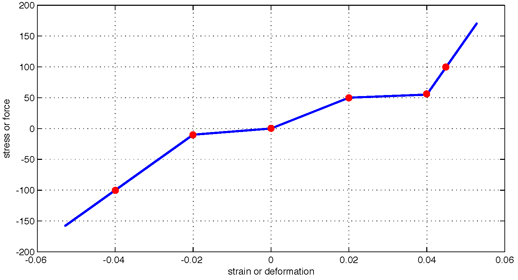ElasticMultiLinear Material: Difference between revisions
(Created page with '{{CommandManualMenu}} This command is used to construct a multi-linear elastic uniaxial material object. {| | style="background:yellow; color:black; width:800px" | '''uniaxial...') |
mNo edit summary |
||
| (21 intermediate revisions by one other user not shown) | |||
| Line 2: | Line 2: | ||
This command is used to construct a multi-linear elastic uniaxial material object. | This command is used to construct a multi-linear elastic uniaxial material object. | ||
The nonlinear stress-strain relationship is given by a multi-linear curve that is define by a set of points. | |||
The behavior is nonlinear but it is elastic. This means that the material loads and unloads along the same curve, and no energy is dissipated. | |||
The slope given by the last two specified points on the positive strain axis is extrapolated to infinite positive strain. | |||
Similarly, the slope given by the last two specified points on the negative strain axis is extrapolated to infinite negative strain. | |||
The number of provided strain points needs to be equal to the number of provided stress points. | |||
{| | {| | ||
| style="background:yellow; color:black; width:800px" | '''uniaxialMaterial ElasticMultiLinear $matTag -strain $strainPoints -stress $stressPoints''' | | style="background:yellow; color:black; width:800px" | '''uniaxialMaterial ElasticMultiLinear $matTag <$eta> -strain $strainPoints -stress $stressPoints''' | ||
|} | |} | ||
| Line 11: | Line 16: | ||
{| | {| | ||
| style="width:150px" | '''$matTag ''' || integer tag identifying material | | style="width:150px" | '''$matTag ''' || integer tag identifying material | ||
|- | |||
| '''$eta ''' || damping tangent (optional, default=0.0) | |||
|- | |- | ||
| '''$strainPoints ''' || array of strain points along stress-strain curve | | '''$strainPoints ''' || array of strain points along stress-strain curve | ||
| Line 16: | Line 23: | ||
| '''$stressPoints ''' || array of stress points along stress-strain curve | | '''$stressPoints ''' || array of stress points along stress-strain curve | ||
|} | |} | ||
[[File:ElasticMultiLinear.png]] | |||
---- | |||
EXAMPLE: | |||
uniaxialMaterial ElasticMultiLinear 1 -strain -0.04 -0.02 0.0 0.02 0.04 0.045 -stress -100 -10 0 50 55 100 | |||
---- | ---- | ||
Code Developed by: <span style="color:blue"> | Code Developed by: <span style="color:blue"> Andreas Schellenberg, University of California, Berkeley. </span> | ||
Latest revision as of 14:53, 18 May 2024
- Command_Manual
- Tcl Commands
- Modeling_Commands
- model
- uniaxialMaterial
- ndMaterial
- frictionModel
- section
- geometricTransf
- element
- node
- sp commands
- mp commands
- timeSeries
- pattern
- mass
- block commands
- region
- rayleigh
- Analysis Commands
- Output Commands
- Misc Commands
- DataBase Commands
This command is used to construct a multi-linear elastic uniaxial material object. The nonlinear stress-strain relationship is given by a multi-linear curve that is define by a set of points. The behavior is nonlinear but it is elastic. This means that the material loads and unloads along the same curve, and no energy is dissipated. The slope given by the last two specified points on the positive strain axis is extrapolated to infinite positive strain. Similarly, the slope given by the last two specified points on the negative strain axis is extrapolated to infinite negative strain. The number of provided strain points needs to be equal to the number of provided stress points.
| uniaxialMaterial ElasticMultiLinear $matTag <$eta> -strain $strainPoints -stress $stressPoints |
| $matTag | integer tag identifying material |
| $eta | damping tangent (optional, default=0.0) |
| $strainPoints | array of strain points along stress-strain curve |
| $stressPoints | array of stress points along stress-strain curve |
EXAMPLE:
uniaxialMaterial ElasticMultiLinear 1 -strain -0.04 -0.02 0.0 0.02 0.04 0.045 -stress -100 -10 0 50 55 100
Code Developed by: Andreas Schellenberg, University of California, Berkeley.
